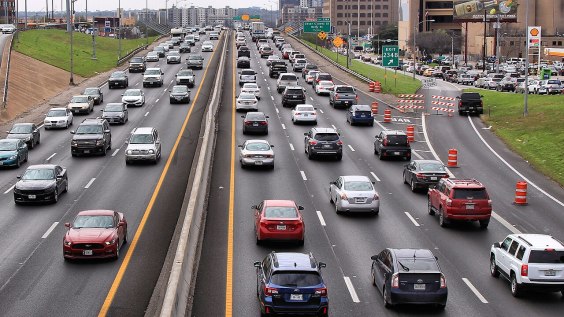Experience with case studies has made it clear to many urban
planners and environmentalists that to maximize the benefits of transit
investments, and to slow growth in traffic congestion, vehicle miles
traveled (VMT), and carbon emissions, you have to focus on land use.
 Photo: Penn State.
Photo: Penn State.This
knowledge has begun working its way into the policymaking world, to the
extent that local and state legislatures are beginning to craft rules
that explicitly factor the carbon impact of land use effects into
decisions about new development and infrastructure construction. In a
few years time, the federal government may follow.
But there's not as much in the way of hard studies of the
effects of land use as we might like -- mainly because it's been a
non-issue, so far as most of the country is concerned, for much of
recent history.
Aiming to address this (and acting under a
congressional mandate), the Transportation Research Board recently
completed a study that has now resulted in a very large report: "Driving and the Built Environment: The Effects of Compact Development on Motorized Travel, Energy Use, and CO Emissions."
The
report is actually five mini-papers, and at nearly 200 pages long it
makes for a lot of reading. But the findings reported in the
introduction give an idea of what it's all about.
The authors
conclude that compact development is likely to reduce VMT: "The effects
of compact, mixed-use development on VMT are likely to be enhanced when
this strategy is combined with other policy measures that make
alternatives to driving relatively more convenient and affordable." No
surprises there.
Finding No. 2 is: "The literature suggests
that doubling residential density across a metropolitan area might
lower household VMT by about 5 to 12 percent, and perhaps by as much as
25 percent, if coupled with higher employment concentrations,
significant public transit improvements, mixed uses, and other
supportive demand management measures."
They note that were
you to move the residents of Atlanta to an area built like Boston,
you'd lower the Atlantans' VMT per household by perhaps 25 percent.
Better
land use results in reductions in energy use and carbon emissions, the
authors report, from both direct and indirect causes. (Direct causes
would be a reduction in VMT; indirect include things like longer
vehicle lifetimes from reduced use and the greater efficiency of
smaller or multi-family housing units.)
But one of the crucial pieces of data included in the report is this:
Asmany as 57 million new housing units are projected to accommodatepopulation growth and replacement housing needs by 2030, growing tobetween 62 and 105 million units by 2050 - a substantial net additionto the housing stock of 105.2 million in 2000.
Critics
of smart growth efforts or rail and transit investments often wave off
the potential gains from building differently by noting that so much of
the current housing stock is of the sprawling, single-family home,
auto-oriented sort. Convincing the people who currently live in such
places to give that up for something different, they say, is sure to be
an extremely difficult sell.
But that's not the issue. No one
is suggesting we rip down all of suburbia. Rather we, or at least I, am
pointing out that between now and mid-century, the country will very
nearly have to build itself all over again to accommodate population
growth. In addition to the 100 million homes now in America, somewhere
between 62 and 105 million more will be built.
The critical
question is what the balance of that new construction will look like.
The TRB report suggests that if 75 percent of this new construction is
of a more compact variety, that emissions could be reduced 10 percent
or more from the baseline scenario (and that is not taking into
consideration the deployment of cleaner electricity generation and
other potential sources of savings).
Ed Glaeser argued
-- and this is kind of hard to believe -- that land use shifts from
building high-speed rail between Dallas and Houston would not provide
much in the way of benefits, since, he guessed, only 100,000 or so
people in each city would move from the suburbs to the central city.
But this entirely misses the point.
Houston and Dallas may each double their current housing stock between now and 2050. Where are those homes going to go, with what climate impacts? That's the critical question.
Demographic
shifts and changes in energy prices are sure to encourage some
households that are currently living at low densities to move to more
compact developments, and that's a good thing. But that's not the main
reason to begin focusing on the significant available savings from
smarter land use decisions.
The main reason is the growth
that America will continue to face. It's difficult to imagine that the
nation can double its housing stock while building in a sprawling
fashion without facing major environmental costs and economic
difficulties. Land use patterns will need to change. And as this report
documents, there will be considerable advantages to facilitating that
change.





